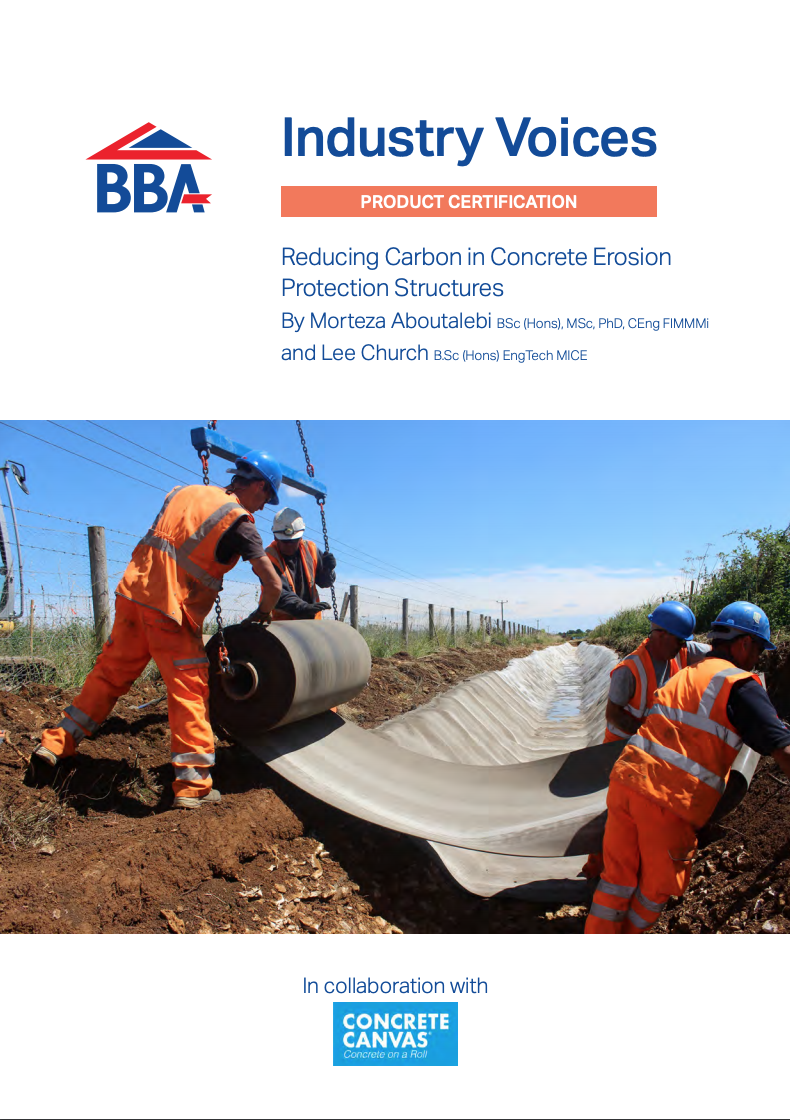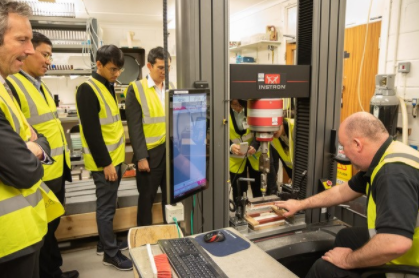Thai road experts consider BBA HAPAS-style solution
Challenges faced by the Department of Rural Roads (DRR) in Thailand may differ from road authorities in the UK but their aims are the same – to provide safe, well-maintained highways and bridges to link communities and aid economic development.
As part of this remit a delegation from the DRR recently visited the UK on a fact-finding mission to discover more about how the UK’s road network operates and how it sets standards and certificates innovate highway construction products via the HAPAS scheme and this trip included a visit to the British Board of Agrément.
At the BBA, the DRR’s road safety, planning and engineering experts were keen to understand how the BBA HAPAS scheme works, with a view to adopting a similar approach in Thailand, as Chakree Bamrumgwong, DRR Director of Office of Road Safety Audit, outlined: “The DRR needs to set up a highways material standard like HAPAS for the quality control of the material and products used in Thailand’s rural and local roads. From visiting the BBA we learned a lot about the HAPAS system and other useful information, all of which supports our thinking to do more for the future. If the BBA can support us, an equivalent DRR HAPAS system will be more possible.”
DRR remit
The DRR is responsible for 47,900km of Thailand’s 396,600km road network, 42,643km of which are paved roads and just over 5,000km laterite (earth) roads. The Thai Department of Highway has responsibility for 51,500km of arterial roads and local governments control 297,000km of local roads, of which 114,000km are paved and 183,000km of laterite construction.
Nationally, roads have been planned on a feeder network to service areas of agricultural and tourism importance via transportation nodes. The DRR’s focus is predominantly to service economic and social activities, for example access to schools, hospitals and emergency assistance. It is active in upgrading laterite roads to tarmacadam in order to reduce the spread of dust, improve local economies and quality of life for residents and has responsibility for bridge construction to connect communities and provide ‘missing links’ in the road network. In addition, it also supports national development strategies for tourism, logistics and agriculture.
Quality and consistency
The department has identified that it needs to bring quality and consistency to highway product specification, both for constructing new roads and bridges but also maintaining existing ones. “If we don’t have the right standards local governments will use many products and the quality of these products will not be consistent,” Mr Bamrumgwong told the BBA. “Some will be good and some will be not so good so we want to standardise it. It is very useful to learn from the BBA.”
A 10 year plan to centralise and standardise highways specifications has been set by the DRR, which at present utilises predominantly American standards for highway product specification and design and, where they prove insufficient, looks to other international standards – including British Standards – to translate into projects. The department also intends to take the lead on encouraging all agencies involved in the Thai road network to collaborate in a further move to drive up product and safety standards.
Innovation
During the visit, Steve Hunt, the BBA’s Sector Manager – Highways, explained the background to HAPAS and how it provides a route to market for product innovations not within the remit of British Standards and unites manufacturers, industry/government bodies, clients and innovators in a voluntary and co-ordinated process recognised by Highways England.
BBA Deputy Chief Executive Brian Moore outlined how influential government was in creating the right environment for HAPAS to succeed when it was established more than 20 years ago by encouraging the industry, including manufacturers, to work in partnership: “We wouldn’t have been able to do this without the government thinking that it needed to establish partnerships to facilitate action. The power and influence of the government to suggest that people co-operate is really important,” he said.
Mr Bamrumgwong acknowledged this approach: “We like this idea and have already started to organise meetings with manufacturers and academics to sit together. Any kind of innovation that can make our work more efficient or better we will try to do.” He explained how many Thai scholarship students who study highway engineering overseas return to work within government departments rather than entering universities or academies, perpetuating the use of what he described as ‘old technology’.
The delegation heard how the driver for HAPAS was the UK Department of Transport and the Highways Agency’s need to assess the many new products coming to market and address road safety issues, for example crack sealant systems creating low friction surfaces subsequently blamed for road accidents. Research identified that adding aggregates to the bitumen created greater friction, helping solve the problem.
Research funding
Mr Moore outlined how the UK government incentivises investment in product innovation via a number of channels, for example tax rebates, matched funding and levies and suggested that the DRR could advise product manufacturers on areas they wanted research conducting. “We have found it is the manufacturers who have the ideas because they live with the issues every day. They are the ones that can be encouraged to come up with ideas and you can use your office to encourage that. For example, ask that the research they are doing is conducted in specific areas and you want to see the best ideas – and those are the ones you will work with. You can define the problems, for example skid resistance and pot holes, and ask manufacturers to solve them. Build strong partnerships, use the power of your office to do things and incentivise research. This approach was, in part, one of the enabling factors that got HAPAS up and running.”
Public liability
UK product manufacturers and contractors are legally obliged to have Public Liability Insurance but this is not the case in Thailand, as Mr Bamrumgwong explained: “The person who has the accident sues the department. Contractors have to guarantee their work for two years but if an accident happens during those two years the people still sue the department…after work is completed (on a road project) the department appoints an inspection committee to check whether that product is built to our standard. If they check and certify that it complies to the standard it becomes our liability if something happens.”
After the meeting Mr Bamrumgwong said the UK trip had been ‘very useful and valuable’ for the DRR. “We learnt about the UK road network from main organisations to local roads, including Nottinghamshire County Council – via East Midlands Ltd, the motorways (Highways England) and Department for Transport (central government) which set up the policy.
“The learning was not only from the meeting but also from the driving experience in the UK, from very very local roads to major A roads and motorways. We have many ideas and can bring the things that we learned from the trip to improve our roads in Thailand.”
Brian Moore said the BBA was ‘delighted’ to welcome the DRR representatives to the BBA’s headquarters in Watford. “The discussions were really interesting and enabled us to learn about highway infrastructure delivery in Thailand while at the same time enabling our visitors to understand better how HAPAS works, what’s necessary for a scheme of this nature to be established and achieve success and how the industry needs to work together. It was a really positive day and we intend to remain in contact with the DRR should it need further assistance.”
Share This Story, Choose Your Platform!
Related News
Thai road experts consider BBA HAPAS-style solution
Challenges faced by the Department of Rural Roads (DRR) in Thailand may differ from road authorities in the UK but their aims are the same – to provide safe, well-maintained highways and bridges to link communities and aid economic development.
As part of this remit a delegation from the DRR recently visited the UK on a fact-finding mission to discover more about how the UK’s road network operates and how it sets standards and certificates innovate highway construction products via the HAPAS scheme and this trip included a visit to the British Board of Agrément.
At the BBA, the DRR’s road safety, planning and engineering experts were keen to understand how the BBA HAPAS scheme works, with a view to adopting a similar approach in Thailand, as Chakree Bamrumgwong, DRR Director of Office of Road Safety Audit, outlined: “The DRR needs to set up a highways material standard like HAPAS for the quality control of the material and products used in Thailand’s rural and local roads. From visiting the BBA we learned a lot about the HAPAS system and other useful information, all of which supports our thinking to do more for the future. If the BBA can support us, an equivalent DRR HAPAS system will be more possible.”
DRR remit
The DRR is responsible for 47,900km of Thailand’s 396,600km road network, 42,643km of which are paved roads and just over 5,000km laterite (earth) roads. The Thai Department of Highway has responsibility for 51,500km of arterial roads and local governments control 297,000km of local roads, of which 114,000km are paved and 183,000km of laterite construction.
Nationally, roads have been planned on a feeder network to service areas of agricultural and tourism importance via transportation nodes. The DRR’s focus is predominantly to service economic and social activities, for example access to schools, hospitals and emergency assistance. It is active in upgrading laterite roads to tarmacadam in order to reduce the spread of dust, improve local economies and quality of life for residents and has responsibility for bridge construction to connect communities and provide ‘missing links’ in the road network. In addition, it also supports national development strategies for tourism, logistics and agriculture.
Quality and consistency
The department has identified that it needs to bring quality and consistency to highway product specification, both for constructing new roads and bridges but also maintaining existing ones. “If we don’t have the right standards local governments will use many products and the quality of these products will not be consistent,” Mr Bamrumgwong told the BBA. “Some will be good and some will be not so good so we want to standardise it. It is very useful to learn from the BBA.”
A 10 year plan to centralise and standardise highways specifications has been set by the DRR, which at present utilises predominantly American standards for highway product specification and design and, where they prove insufficient, looks to other international standards – including British Standards – to translate into projects. The department also intends to take the lead on encouraging all agencies involved in the Thai road network to collaborate in a further move to drive up product and safety standards.
Innovation
During the visit, Steve Hunt, the BBA’s Sector Manager – Highways, explained the background to HAPAS and how it provides a route to market for product innovations not within the remit of British Standards and unites manufacturers, industry/government bodies, clients and innovators in a voluntary and co-ordinated process recognised by Highways England.
BBA Deputy Chief Executive Brian Moore outlined how influential government was in creating the right environment for HAPAS to succeed when it was established more than 20 years ago by encouraging the industry, including manufacturers, to work in partnership: “We wouldn’t have been able to do this without the government thinking that it needed to establish partnerships to facilitate action. The power and influence of the government to suggest that people co-operate is really important,” he said.
Mr Bamrumgwong acknowledged this approach: “We like this idea and have already started to organise meetings with manufacturers and academics to sit together. Any kind of innovation that can make our work more efficient or better we will try to do.” He explained how many Thai scholarship students who study highway engineering overseas return to work within government departments rather than entering universities or academies, perpetuating the use of what he described as ‘old technology’.
The delegation heard how the driver for HAPAS was the UK Department of Transport and the Highways Agency’s need to assess the many new products coming to market and address road safety issues, for example crack sealant systems creating low friction surfaces subsequently blamed for road accidents. Research identified that adding aggregates to the bitumen created greater friction, helping solve the problem.
Research funding
Mr Moore outlined how the UK government incentivises investment in product innovation via a number of channels, for example tax rebates, matched funding and levies and suggested that the DRR could advise product manufacturers on areas they wanted research conducting. “We have found it is the manufacturers who have the ideas because they live with the issues every day. They are the ones that can be encouraged to come up with ideas and you can use your office to encourage that. For example, ask that the research they are doing is conducted in specific areas and you want to see the best ideas – and those are the ones you will work with. You can define the problems, for example skid resistance and pot holes, and ask manufacturers to solve them. Build strong partnerships, use the power of your office to do things and incentivise research. This approach was, in part, one of the enabling factors that got HAPAS up and running.”
Public liability
UK product manufacturers and contractors are legally obliged to have Public Liability Insurance but this is not the case in Thailand, as Mr Bamrumgwong explained: “The person who has the accident sues the department. Contractors have to guarantee their work for two years but if an accident happens during those two years the people still sue the department…after work is completed (on a road project) the department appoints an inspection committee to check whether that product is built to our standard. If they check and certify that it complies to the standard it becomes our liability if something happens.”
After the meeting Mr Bamrumgwong said the UK trip had been ‘very useful and valuable’ for the DRR. “We learnt about the UK road network from main organisations to local roads, including Nottinghamshire County Council – via East Midlands Ltd, the motorways (Highways England) and Department for Transport (central government) which set up the policy.
“The learning was not only from the meeting but also from the driving experience in the UK, from very very local roads to major A roads and motorways. We have many ideas and can bring the things that we learned from the trip to improve our roads in Thailand.”
Brian Moore said the BBA was ‘delighted’ to welcome the DRR representatives to the BBA’s headquarters in Watford. “The discussions were really interesting and enabled us to learn about highway infrastructure delivery in Thailand while at the same time enabling our visitors to understand better how HAPAS works, what’s necessary for a scheme of this nature to be established and achieve success and how the industry needs to work together. It was a really positive day and we intend to remain in contact with the DRR should it need further assistance.”
Share This Story, Choose Your Platform!
Related News
Get in touch
Please complete the form below and we will contact you as soon as possible.
To help us to respond to your inquiry as quickly as possible, we have put a handy list of our services below.


